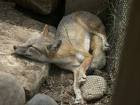But, Soledad does have a fine little cemetery.
Lots of requisite angels.
My favorite: the dramtaic weeping angel.
Here's a coy little cherub.
Here is a very unusual headstone with a representation of rosary beads.
No comment.
Ditto.
I have absolutely nothing to say about this headstone except that he was an American Freemason. British Masons do not use the "G" in their symbol. Like almost everything about the Freemasons, the exact meaning of the "G" is unclear, but it is thought to represent God or geometry, both revered by the Masons.
This five-pointed star has many meanings. It is a very old symbol. Here, it is hard to make out the specific interpretation of this one, but it could stand for a number of societies for women, including the Order of the Eastern Star, a female-only offshoot of the Freemasons.
Grave markers carved in the shape of trees or stumps were popular in Victorian times. They were a product of the rusticity movement. They are also used very frequently to mark the grave of a member of the Woodsmen of the World. Members received insurance-like benefits from the organization, including, according to their bylaws, a tombstone upon their death.
Here is an example of a sarcophagus tomb. Most sarcophagus tombs do not actually contain bodies. I did not get close enough to find out if this one does.
Once you enter Soledad, it is very hard to leave again.





































